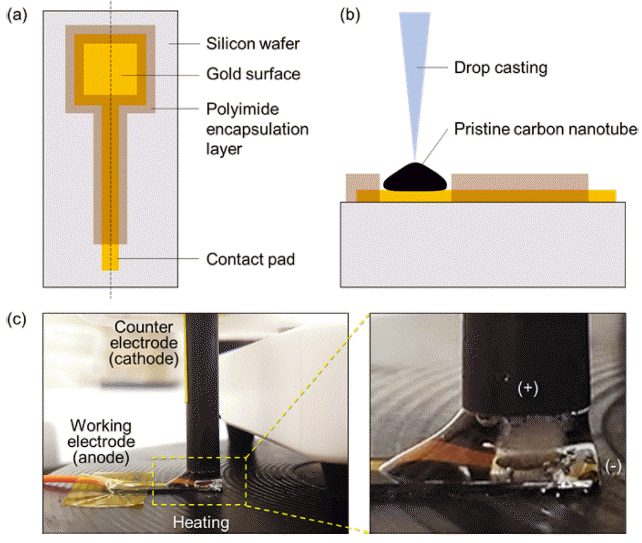Search
- Page Path
- HOME > Search
- [Korean]
- Capacitance Enhancement and Evaluation of Gold-Deposited Carbon Nanotube Film Ion-Selective Electrode
- Do Youn Kim, Hanbyeol Son, Hyo-Ryoung Lim
- J Powder Mater. 2023;30(4):310-317. Published online August 1, 2023
- DOI: https://doi.org/10.4150/KPMI.2023.30.4.310

- 798 View
- 7 Download
-
 Abstract
Abstract
 PDF
PDF Small-film-type ion sensors are garnering considerable interest in the fields of wearable healthcare and home-based monitoring systems. The performance of these sensors primarily relies on electrode capacitance, often employing nanocomposite materials composed of nano- and sub-micrometer particles. Traditional techniques for enhancing capacitance involve the creation of nanoparticles on film electrodes, which require cost-intensive and complex chemical synthesis processes, followed by additional coating optimization. In this study, we introduce a simple one-step electrochemical method for fabricating gold nanoparticles on a carbon nanotube (Au NP–CNT) electrode surface through cyclic voltammetry deposition. Furthermore, we assess the improvement in capacitance by distinguishing between the electrical double-layer capacitance and diffusion-controlled capacitance, thereby clarifying the principles underpinning the material design. The Au NP–CNT electrode maintains its stability and sensitivity for up to 50 d, signifying its potential for advanced ion sensing. Additionally, integration with a mobile wireless data system highlights the versatility of the sensor for health applications.
- [Korean]
- Synthesis and Characterization of Nickel Nanowires by an Anodic Aluminum Oxide Template-Based Electrodeposition
- Hyo-Ryoung Lim, Yong-Ho Choa, Young-In Lee
- J Korean Powder Metall Inst. 2015;22(3):216-220. Published online June 1, 2015
- DOI: https://doi.org/10.4150/KPMI.2015.22.3.216

- 634 View
- 2 Download
-
 Abstract
Abstract
 PDF
PDF Vertically oriented nickel nanowire arrays with a different diameter and length are synthesized in porous anodic aluminium oxide templates by an electrodeposition method. The pore diameters of the templates are adjusted by controlling the anodization conditions and then they are utilized as templates to grow nickel nanowire arrays. The nickel nanowires have the average diameters of approximately 25 and 260 nm and the crystal structure, morphology and microstructure of the nanowires are systematically investigated using XRD, FE-SEM and TEM analysis. The nickel nanowire arrays show a magnetic anisotropy with the easy axis parallel to the nanowires and the coercivity and remanence enhance with decreasing a wire diameter and increasing a wire length.
TOP
 KPMI
KPMI

 First
First Prev
Prev


